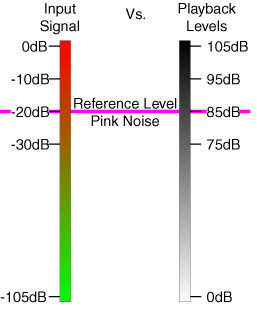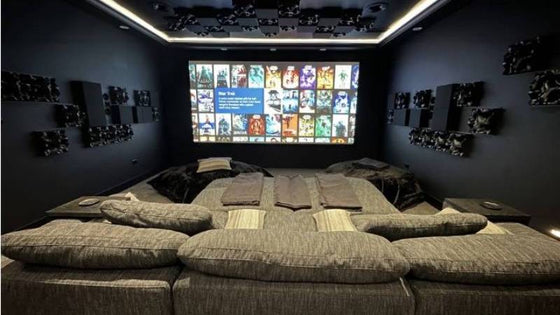Creating a system you love shouldn't be difficult. The Acoustic Frontiers blog is here to help.

Reference level is a calibrated volume setting used for both movie production (in dubbing stages and post production houses) and reproduction (in screening rooms and theaters). The human hearing system is non-linear, especially in the bass, so having a consistent playback level – a reference – is critical if the mix is to translate from one production house to another and audiences are to hear the director’s intent in terms of the balance in the soundtrack between dialog, effects and ambiance.

Reference level for all channels except low frequency effects is calibrated by adjusting the audio chain such that a pink noise signal recorded at -20dB relative to full scale (0dB) creates 85dB sound pressure level as measured with a C weighted SPL meter at the seating locations. Volume levels are adjusted for each channel individually until they read 85dB. The master volume control setting associated with this playback level is then set to a nominal 0dB, or reference level. The history behind this is that sound engineers and producers generally work so that the average recording level for dialog in movie soundtrack is -20dB. This allows for 20dB of dynamic range in the soundtrack. The low frequency effects channel is calibrated higher, so that a -20dB signal reaches 95dBC at the seating locations.

In the home it works slightly differently. Most pre-processor and audio video receivers have embedded pink noise test tones used for level setting that are recorded at -30dB relative to full scale. Using these tones the level of individual speakers are adjusted to 75dB as measured with a C weighted SPL meter at the listening position. Note that the low frequency effects signal is nearly always internally set to be to be 10dB louder than that for the speakers so that the end user’s life is simplified and the subwoofer is calibrated to 75dB rather than the 85dB one might expect.
The concept of reference level ensures that the content is produced and reproduced at the same absolute volume level and is cemented in the THX certification process for theaters and consumer gear.
Reference level means two things for home theater design:
1. Speakers and amplifiers must be capable of 105dB peaks
If the playback chain is calibrated to produce 85dB for a -20dB signal at the listening position then the speakers and amplifiers could be asked to produce 105dB for a 0dB signal. It is a challenging proposition for an audio system to reproduce this level cleanly, without dynamic compression and to be able to do so reliably. Most standard consumer technologies such as soft dome tweeters are not up to scratch in any reasonably sized room. Speakers should have high sensitivity and high power handling, such as the Procella Audio speakers we recommend and use.
2. Subwoofers must be capable of 115dB peaks
The low frequency effects channel is handled slightly differently and has a 10dB boost relative to the other channels. The maximum SPL that subwoofers could be asked to reproduce from the low frequency effects track is therefore 115dB at the listening position. In reality the situation is nearly always worse because the subwoofer must additionally reproduce bass managed* content from other channels. These challenges mean that multiple large subwoofers are typically needed to be able to properly reproduce the soundtrack as the director intended.
* Bass managed content is that from other speaker channels that has been diverted to the subwoofer. In home audio video receivers (AVRs) and pre-processors this is done by setting the speakers to small in the bass management menu and specifying a crossover frequency. With surround speakers, for example, an 80Hz crossover is typically used. This means that any content in the surround channels under 80Hz is essentially diverted to the subwoofer. For 5 bass managed speakers an additional 6dB and for 7 bass managed speakers an additional 8dB of output may be required from the subwoofer channel.
We have written two calculators that allow you to determine if your speaker/amplifier system and subwoofer systems [forthcoming blog article] are capable of achieving reference level.
In our demo room we use the Procella Audio P610 speakers. The ‘head unit’ of these speakers is a P6 with 90dB sensitivity and 300W peak power handling. The listening distance is 11ft maximum in our room. Plugging these numbers into our calculator shows that this speaker is cable of reference level since peak amplifier watts is less than the maximum power handling.

Learn how early home theater design, layout, and acoustic treatment improve performance in new home construction.
This media room was intentionally designed to feel like part of the home—not a separate, tech-heavy space. Through careful acoustic planning, equipment integration, and final calibration, we achieved a room that is both beautiful to live in and immersive to experience.
"No other subwoofer system I’ve owned even comes close to what this room delivers. Reaching out to Acoustic Frontiers was one of the best decisions I’ve made—I highly recommend working with them if you want to get the most out of your theater."

Nyal Mellor, Founder, Acoustic Frontiers



Nyal Mellor
Author